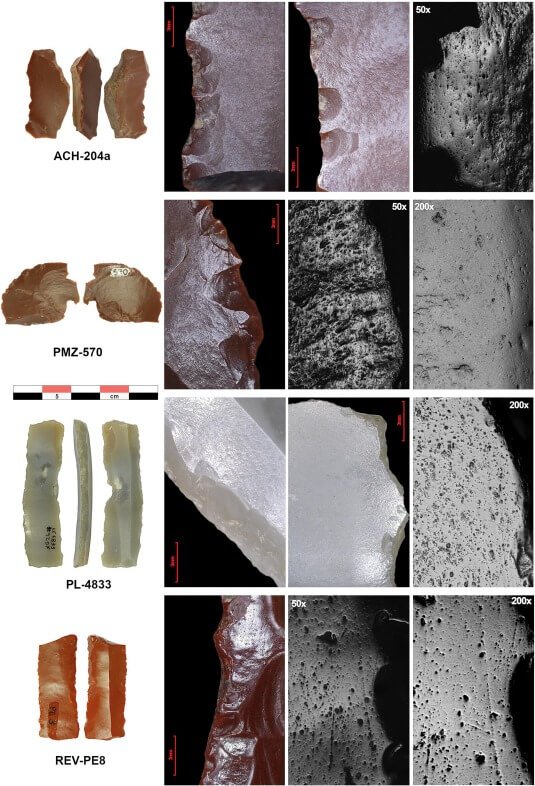A new study presents evidence of the early use of threshing sledges in Neolithic Greece through the analysis of macro- and microscopic use-wear traces on archaeological tools. These findings suggest that threshing sledges were employed from the early phases of the Neolithic period, around 6500 cal BCE. The integration of traditional use-wear analysis with quantitative methods, including confocal microscopy, has provided a deeper understanding of the early agricultural practices in the region. This research contributes to a broader understanding of Neolithic farming systems and the diffusion of agricultural technologies from the Near East to Europe.
The development of mechanical innovations such as chariots, ploughs, and threshing sledges played a crucial role in agricultural productivity and societal changes in prehistoric periods. The threshing sledge, or tribulum, facilitated the processing of large amounts of cereals and was integral to increased agricultural output. While traditionally associated with later Neolithic phases, this study explores the potential earlier use of threshing sledges in Neolithic Greece.
The Neolithic Site Of Dispilio: Interactive Learning Of A Neolithic Settlement In Northern Greece
Materials and Methods
Geographical framework and location of studied sites. ACH: Achilleion; PLA: Platia Magoula Zarkou; PL: Paliambella; REV: Revenia Korinos.
Archaeological Sites
The study focuses on four Neolithic sites in Greece: Achilleion, Platia Magoula Zarkou, Revenia Korinos, and Paliambela Kolindros. These sites span different phases of the Neolithic period and provide a comprehensive sample of early agricultural tools.
Archaeological Tools
Flaked stone tools from these sites were analyzed using stereoscopic and reflected-light microscopy to identify macro- and microwear patterns indicative of agricultural activities. The tools were further analyzed using a Sensofar Plu Neox blue light scanning confocal microscope to quantify the wear traces.
Results
Macroscopic and Microscopic Analysis
The analysis identified 250 harvesting inserts and 8 potential threshing sledge inserts. The threshing sledge inserts were characterized by heavily worn, rounded edges and mixed plant polish with abrasions, distinct from the glossy, smooth surfaces of harvesting inserts.
Quantitative Analysis
Confocal microscopy provided a quantitative comparison of the use-wear traces. Parameters such as core height, material ratio, and surface roughness were used to distinguish between different types of wear. The results confirmed that the threshing sledge inserts exhibited wear patterns consistent with those found on ethnographic and experimental threshing sledges.
Colin Renfrew’s Anatolian Hypothesis: Tracing The Roots Of Proto-Indo-European
Discussion
Selection of harvesting inserts used for quantitative analysis through confocal microscopy.
Early Use of Threshing Sledges
The findings suggest that threshing sledges were in use in Greece by 6500 cal BCE, earlier than previously documented. This early adoption indicates a rapid diffusion of agricultural technologies from the Near East to Europe during the Neolithic expansion.
Implications for Neolithic Farming
The use of threshing sledges would have significantly increased agricultural productivity, facilitating the accumulation of surplus crops and possibly contributing to social and economic changes. The evidence aligns with the broader context of early Neolithic innovations in farming practices, including the use of animal traction for various agricultural tasks.
Conclusions
This study provides new insights into the early use of threshing sledges in Neolithic Greece, challenging the traditional timeline of their introduction. The integration of quantitative methods with traditional use-wear analysis has enhanced the understanding of early agricultural practices and the diffusion of technology in the Neolithic period.
This research was supported by various grants and institutions, including the Italian Ministry for Education, Universities and Research, the Marie Sklodowska-Curie Individual Fellowship, and the University of Pisa. The authors express gratitude to collaborators and institutions that facilitated the study.
Selection of archaeological harvesting implements from the studied sites, on both flakes and blades. Note the presence of glossy, highly reflective, surfaces. At a microscopic level, smooth and flat polishes, with stria, pits, and comet tails like features are visible.









